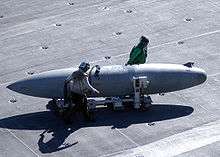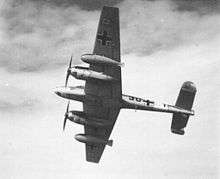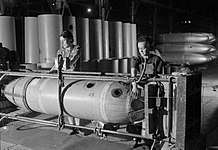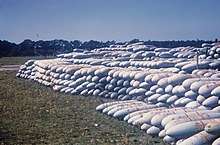Drop tank
In aviation, a drop tank (external tank, wing tank, or belly tank) is used to describe auxiliary fuel tanks externally carried by aircraft. A drop tank is expendable and often jettisonable. External tanks are commonplace on modern military aircraft and occasionally found in civilian ones, although the latter are less likely to be discarded except in the event of emergency.

Overview
.jpg)
The primary disadvantage with drop tanks is that they impose a drag penalty on the aircraft carrying them. External fuel tanks will also increase the moment of inertia, thereby reducing roll rates for air maneuvres. Some of the drop tank's fuel is used to overcome the added drag and weight of the tank itself. Drag in this sense varies with the square of the aircraft's speed. The use of drop tanks also reduces the number of external hardpoints available for weapons, reduces the weapon-carrying capacity, and increases the aircraft's radar signature.
Usually the fuel in the drop tanks is consumed first, and only when all the fuel in the drop tanks has been used, the fuel selector is switched to the airplane's internal tanks.
Some modern combat aircraft use conformal fuel tanks (CFTs) instead of or in addition to conventional external fuel tanks. CFTs produce less drag and do not take up external hardpoints; however, some versions can only be removed on the ground.
History


The drop tank was used during the Spanish Civil War to allow fighter aircraft to carry additional fuel for long-range escort flights without requiring a dramatically larger, heavier, less maneuverable fuselage. During World War II, the German Luftwaffe began using external fuel tanks with the introduction of a 300-liter (80 US gallon) light alloy model for the Ju 87R, a long-range version of the Stuka dive bomber, in early 1940. The Messerschmitt Bf 109 fighter also used this type of drop tank, starting with the Bf 109E-7 variant introduced in August 1940. Fitted also to the Focke-Wulf Fw 190, the 300 liter tank, available in at least four differing construction formats — including at least one impregnated paper material, single-use version — and varying only slightly in appearance, became the standard volume for most subsequent drop tanks in Luftwaffe service, with a rarely used 900 litre (238 U.S. gallon), fin-stabilized large capacity drop tank used with some marks of the Messerschmitt Bf 110 heavy fighter and other twin-engined Luftwaffe combat aircraft.
The first drop tanks were designed to be discarded when empty or in the event of combat or emergency in order to reduce drag, weight, and to increase maneuverability. Modern external tanks may be retained in combat, to be dropped in an emergency.
The Allies commonly used them to allow fighters increased range and patrol time over continental Europe. The RAF used such external fuel tanks in 1942, during the transit of Supermarine Spitfires to Malta.

The Imperial Japanese navy design specification for what came to be the Japanese Mitsubishi A6M Zero fighter included endurance with drop tanks of two hours at full power, or six to eight hours at cruising speed. Drop tanks were commonly used with the Zero, even on Combat Air Patrol (CAP).[1] The Zero entered service in 1940.
Bomber theorists insisted formations of heavy bombers with elaborate defensive armaments would be self-defending, believing long-range escort fighters to be "a myth"[2] as they could be easily forced to drop the tanks by minor harassment at the beginning of the raid[2] being more concerned that long-range medium bombers might compete for resources and so compromise their goal of creating vast fleets of heavy bombers.[3] In the face of such entrenched attitudes in 1941 airmen such as Benjamin S. Kelsey and Oliver P. Echols worked quietly to get drop tank technology added to American fighters such as the Lockheed P-38 Lightning.

It was only with drop tanks supplying 450 US gallons (1,700 l; 370 imp gal) of extra fuel per fighter that P-38s could carry out Operation Vengeance, the downing of Admiral Isoroku Yamamoto's airplane. (For this mission, each fighter carried one drop tank of approximately 150 to 165 US gal (570 to 620 L), and a larger one of approximately 300 to 330 US gal (1,100 to 1,200 L).[4][5]

Even after such experience showed the necessity for drop tanks, inflexible thinkers such as 8th Air Force General Ira C. Eaker had to be transferred out of commanding positions (and replaced with Maj. Gen. Jimmy Doolittle) so that drop tanks and range extension plans could be widely implemented in 1944 for American escort fighters.[6]
External drop tanks turned the Republic P-47 Thunderbolt from a short-range interceptor aircraft into a long-range escort and air superiority fighter, enabling it to accompany bombers from British Isles into Germany, and made it possible for heavy bomber formations to undertake daylight raids under escort by North American P-51 Mustangs.
The P-38 could also carry two 300-to-330-gallon drop tanks for its longest sorties. This teardrop-shaped tank design was 13 feet (4.0 m) long and 3 feet (0.91 m) in diameter at its widest point.[7]
Paper-based drop tanks


Faced by wartime metal shortages and a need to extend the range of fighter craft, the British came up with drop tanks made of glue-impregnated kraft paper, which had excellent tolerance characteristics for extreme heat and cold necessary for operation on an aircraft as well as being waterproof.
Since the glue would slowly dissolve from the solvent effects of the fuel (sometimes developing leaks within a few hours of being loaded with fuel) these were strictly a single-use item, used in typically chilly Northern European conditions, filled immediately before take off, jettisoned in the event of an aborted mission and only being required for the outbound portion of any flight.
Such papier-mâché tanks were assembled from three main components, the nose cone, tail cone and the body, each shaped over wooden forms, the centre section created by wrapping layers of the impregnated paper around a cylinder, the end caps hand-laminated with petal-shaped pieces sometimes named gores.
Before final assembly wooden anti-slosh baffles were installed, pipes and fittings were attached and the interiors coated with fuel-resistant lacquer and the three pieces were bonded together in press. Once the tank had cured, it was pressure tested to 41 kilopascals (6 psi) and passing tanks were given two coats of cellulose dope followed by two coats of aluminium paint. (British paper drop tanks can be distinguished from outwardly similar metal tanks by colour, paper tanks were silver in appearance, while metal tanks were grey.)[8]
Some 13,000 papier-mâché tanks were made and used by the RAF, the vast majority used in the course of the war, conserving a considerable amount of metal. Very few examples survive due to their expendable nature and low intrinsic value at the time of their creation, and the fact that they are not inherently robust.[8] While probably a nuisance for those under the flight path when the empty tanks were released, as they were lightweight and comparatively fragile it is unlikely to cause anything but anxiety, the Germans authorities going so far as to distribute leaflets, explaining that drop tanks are not bombs.[8]
.jpg)
U.S. paper tanks were developed by Col. Bob Shafer and Col. Cass Hough, who spent many hours developing a 110-gallon (416 litre) paper tank, then getting them into series production at Bowater-Lloyd's of London, only to be told by experts at Wright Field "paper tanks are absolutely unfeasible and will not do the job for which they are intended". Since by the time the experts made that pronouncement 8th Air Force fighters had already used more than 15,000 paper tanks without a failure, the criticism was not taken seriously.
However it may explain why the most often-used fuel tanks for single-engined American fighters operating in Northern Europe were the 75-gallon (284 litre) capacity all-metal tank (made from two halves of formed aluminium with a prominent horizontal seam running along the tank's midline). Another common metal drop tank was the 150-to-165-gallon model used by P-51s, P-47s and P-38s.[9]
Post-war use
The Matra JL-100 is a special hybrid drop tank and rocket pack; it combines a rocket launcher in front with 19 SNEB 68 mm (2.7 in) rockets and 250 litres (66 US gal) of fuel behind into one single aerodynamically-shaped pod for mounting on combat aircraft such as the Dassault Mirage IIIs and English Electric Lightnings.
Automotive use
.jpg)
After World War II, hot rodders raced the dry lakes of California to set new land speed records. War surplus drop tanks were plentiful and aerodynamically neutral, and it did not take long to convert one into a car, dubbed a lakester. According to GM historians,[10] Bill Burke of the So-Cal Speed Shop first attempted to convert a 168-gallon P-51 Mustang belly tank, before switching to the larger 305-gallon P-38 Lightning tank. Even now, lakesters compete at the Bonneville Salt Flats.
References
- Lundstrom, John B. The First Team: Pacific Naval Air Combat from Pearl Harbor to Midway. Naval Institute Press.
- Rosen, Stephen Peter (1994). Winning the next war: Innovation and the modern military (5th printing. ed.). Ithaca, N.Y: Cornell University Press. pp. 173–177. ISBN 0-8014-8196-1.
- Kelsey, Benjamin S. (1982). The Dragon's Teeth?: The Creation of United States Air Power for World War II. Smithsonian Institution Press. ISBN 0-87474-574-8.
- Air Power History. 50. Air Force Historical Foundation. 2003. pp. 33–34.
- Polmar, Norman (2008). Aircraft Carriers: A History of Carrier Aviation and Its Influence on World Events, Volume II: 1946-2006. Potomac Books. p. 308. ISBN 1574886657.
- Bodie, Warren M. (1991). The Lockheed P-38 Lightning. Widewing Publications. ISBN 0-9629359-5-6.
- Wilkinson, Stephan (2005). Man And Machine: The Best of Stephan Wilkinson. Globe Pequot. p. 97. ISBN 1599216795.
- "Necessity is the Mother of Invention: Paper Drop Tanks of WWII". Warbird News. 13 August 2013. Retrieved 6 August 2016.
- Christensen, Mark; Thacker, Tony (2005). So-Cal Speed Shop: The Fast Tale of the California Racers Who Made Hot Rod History. MotorBooks International. p. 66. ISBN 1610591852.
- 2003 So-Cal Lakester
| Wikimedia Commons has media related to Drop tanks. |